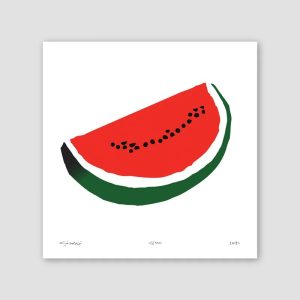The watermelon has long been an emblem of Palestinian resistance, with its colours that represent the Palestinian flag.
Following the 1967 occupation of Palestine, Israeli authorities became so incensed about the Palestinian flag and its colors, that they forbade its flying over Gaza and the West Bank.
Palestinians substituted the locally sourced, similarly colored slices of watermelon as a symbol of protest.
Khaled Hourani, a Palestinian artist, debuted his piece “Watermelon” in 2007 as a contribution to the book Subjective Atlas of Palestine.

This action acted as a spark, encouraging many other artists, including Sarah Hatahet, Sami Boukhari, Aya Mobaydeen, and Beesan Arafat, to create their works of art that use the watermelon as a symbol of solidarity with Palestine.
“Art can sometimes be more political than politics itself,” Hourani told the Washington Post.
Watermelon resurgence has been observed on social media 57 years later, in 2023, in the wake of the Israeli aggression on Palestine since October, that resulted in total death of approximately 11,200 Palestinians, 40 percent of which are children according to statistics.
Now social media users are attempting to get around what they perceive to be online censorship, content filtering, and a noticeable drop in reach of Palestinian or pro-Palestinian content.
“Palestinians are finding creative ways — such as omitting punctuation, changing letters in words, or mixing political statements with personal photos — to overcome and play with the algorithm to prevent posts from being taken down, censored, or flagged,” Mona Shtaya, local advocacy manager at 7amleh, the Arab Centre for the Advancement of Social Media, said to the Washington Post.
For decades, Palestinians have used pictorials like Handala and symbols like the keffiyeh along with many others to protest, grieve, and resist.


